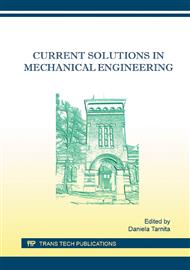[1]
W.A.M., Brekelmans, H.W., Poort, T.J.J.H., Slooff, A new method to analyse the mechanical behaviour of skeletal parts, Acta Orthop. Scand. 43, (1972) 301-317.
DOI: 10.3109/17453677208998949
Google Scholar
[2]
R., Huiskes, E.Y.S., Chao, A Survey of Finite Element Analysis in Orthopedic Biomechanics: The First Decade, J. Biomechanics, 16(6), (1983) 385-409.
DOI: 10.1016/0021-9290(83)90072-6
Google Scholar
[3]
D. Tarnita, M. Catana, D.N. Tarnita, Modeling and Finite Element Analysis of the Human Knee Joint Affected by Osteoarthritis, in Key Engineering Materials, 601, (2014) 147-150.
DOI: 10.4028/www.scientific.net/kem.601.147
Google Scholar
[4]
D. Tarnita, C. Boborelu, et al, The three-dimensional modeling of the complex virtual human elbow joint, Romanian Journal of Morphology and embryology, 51(3), (2010) 489-495.
Google Scholar
[5]
D. Popa, D. Tarnita, D.N. Tarnita, D. Grecu, The generation of the three-dimensional model of the human knee joint, in Rom. Journal of Morphology and Embryology, 46(4), (2005) 3-6.
Google Scholar
[6]
D. Popa, I. Iordachita, I, D. Tarnita, Study Method For Human Knee Applicable To Humanoid Robots, International Workshop on Robotics in Alpe-Adria-Danube Region, proceedings RAAD (2005) 485-490.
DOI: 10.1109/raad.2010.5524565
Google Scholar
[7]
E. Genda, N. Konishi, et al, A computer simulation study of normal and abnormal hip joint contact pressure, Archives of Orthopaedic and Trauma Surgery, 114(4), (1995) 202-206.
DOI: 10.1007/bf00444263
Google Scholar
[8]
N. Konishi, T. Mieno, Determination of acetabular coverage of the femoral head with use of a single anteroposterior radiograph. A new computerized technique. Journal of Bone and joint Surgery, 75A(9), (1993) 1318-1333.
DOI: 10.2106/00004623-199309000-00007
Google Scholar
[9]
A.E. Anderson, B.J. Ellis, S.A. Maas, J.A. Weiss, Effects of idealized joint geometry on finite element predictions of cartilage contact stresses in the hip, Journal of Biomechanics, 43 (2010) 1351–1357.
DOI: 10.1016/j.jbiomech.2010.01.010
Google Scholar
[10]
R. Huiskes, Failed Innovation in total hip replacement; Diagnosis and proposals for a cure, Acta. Orthop. Scand., 64(6) (1993) 699-716.
DOI: 10.3109/17453679308994602
Google Scholar
[11]
SolidWorks Tutorials, 1997-(2015).
Google Scholar
[12]
Ansys Tutorials, 2000-(2014).
Google Scholar


